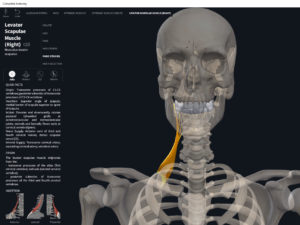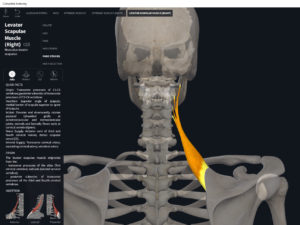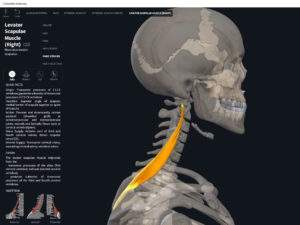Anatomy & Physiology: Muscles—Levator Scapulae.
Structure.
- Origin: transverse processes of C1-C4.
- Insertion: superior vertebral border of scapulae.
Function.
- Concentric action: cervical extension, lateral flexion and ipsilateral rotation when scapulae are anchored; elevation and downward rotation of scapulae. Scapular retraction at scapulocostal joint (ScC).
- Reverse mover action: neck extension at spinal joints; lateral flexion of the neck at spinal joints; ipsilateral rotation of the neck at spinal joints.
- Eccentric action: cervical flexion, contralateral rotation, lateral flexion; scapular depression and upward rotation when neck is stabilized.
- Isometric action: stabilization of the scapulae and cervical spine.
- Innervation: dorsal scapular nerve; cervical spinal nerves C3-C5.
- Arterial supply: dorsal scapular artery (branch of the subclavian artery).
Clinical Significance.
References
Biel, A. (2015). Trail guide to the body: A hands-on guide to locating muscles, bones and more.
Cedars-Sinai. (2018). Vertebrae of the spine. Retrieved from https://www.cedars-sinai.org/health-library/diseases-and-conditions/v/vertebrae-of-the-spine.html
Clark, M., Lucett, S., Sutton, B. G., & National Academy of Sports Medicine. (2014). NASM essentials of corrective exercise training. Burlington, MA: Jones & Bartlett Learning.
Jenkins, G., & Tortora, G. J. (2012). Anatomy and Physiology: From Science to Life, 3rd Edition International Stu. John Wiley & Sons.
Muscolino, J. E. (2017). The muscular system manual: The skeletal muscles of the human body.



